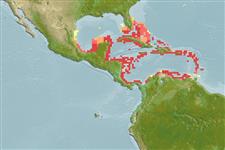Actinopterygii (ray-finned fishes) >
Pleuronectiformes (Flatfishes) >
Cynoglossidae (Tonguefishes) > Symphurinae
Etymology: Symphurus: Greek, syn, symphysis = grown together + Greek, oura = tail (Ref. 45335). More on author: Robins, Randall.
Environment / Climate / Range
Ecology
Marine; reef-associated; depth range 3 - 39 m (Ref. 26268), usually 6 - 30 m (Ref. 26268). Tropical, preferred ?; 30°N - 9°N
Western Atlantic: Florida, USA and Bahamas to Curaçao and Colombia.
Size / Weight / Age
Maturity: Lm ? range ? - ? cm
Max length : 5.1 cm TL male/unsexed; (Ref. 7251)
Short description
Morphology | Morphometrics
Dorsal
soft rays
(total): 69-75;
Anal
soft rays: 56 - 61. Body pale with six to ten large dark blotches which are variously positioned in different individuals but frequently at the periphery of the body; upper and lower blotches are generally in vertical alignment, the last pair often confluent; scattered small dark spots on head and body (Ref. 13442).
Inhabits bays and shallow coastal waters.
Life cycle and mating behavior
Maturity | Reproduction | Spawning | Eggs | Fecundity | Larvae
Munroe, T.A., 1998. Systematics and ecology of tonguefishes of the genus Symphurus (Cynoglossidae: Pleuronectiformes) from the western Atlantic Ocean. Fish. Bull. 96(1):1-182. (Ref. 26268)
IUCN Red List Status (Ref. 115185)
CITES (Ref. 94142)
Not Evaluated
Threat to humans
Harmless
Human uses
Aquarium: commercial
More information
Common namesSynonymsMetabolismPredatorsEcotoxicologyReproductionMaturitySpawningFecundityEggsEgg development
Age/SizeGrowthLength-weightLength-lengthLength-frequenciesMorphometricsMorphologyLarvaeLarval dynamicsRecruitmentAbundance
ReferencesAquacultureAquaculture profileStrainsGeneticsAllele frequenciesHeritabilityDiseasesProcessingMass conversion
Tools
Special reports
Download XML
Internet sources
